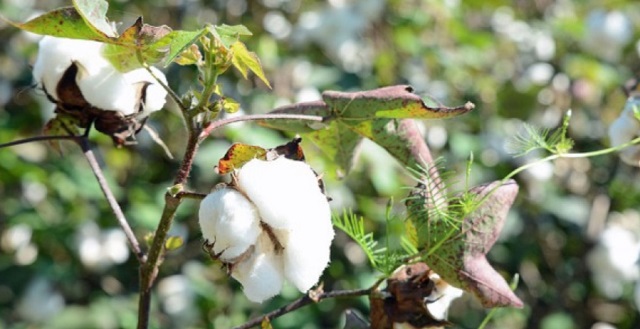
The East African nation is pinning growth of its textile sector on new crop
The Independent | ISAAC KHISA | Kenya has made history as it joined six other African countries in commercial cultivation of BT cotton.
Peter Munya, the country’s Agriculture Cabinet Secretary planted the first BT cotton seed with farmers at Alupe University College, Busia County, on March.09, leaving behind Uganda that first carried out the study on the crop, more than a decade ago.
The Kenyan Cabinet granted approval for commercial farming of the genetically improved cotton on Dec. 19, last year, in a plan to revitalize the country’s cotton, textile and apparel sector.
The planting in Busia marks the first of 1,000 on-farm demonstration plots to be planted in 23 counties for training at least 40,000 farmers prior to full commercial roll-out countrywide.
BT cotton has been improved with the ability to resist the African bollworm, the single most destructive cotton pest, causing up to 100% loss. With BT cotton, Kenyan farmers are expected to enjoy a four-fold reduction in production cost.
“The global experience with BT cotton adopting countries shows the improved variety is a viable intervention to help boost cotton production by addressing the challenges caused by pests in addition to increased yields per unit area and lower cost of production,” Munya said.
He revealed that the country targets to have over 200,000 acres under commercial BT cotton cultivation, creating over 25,000 jobs for Kenyans along the value chain.
“These job opportunities will be in cultivation, processing or trading in locally manufactured garments and clothes,” he said, adding “Cultivation of BT cotton by our farmers will guarantee a constant supply of raw materials to ginneries and cotton processing industries thus supporting value addition and job creation up the value chain.”
BT cotton is currently planted in 15 countries globally covering an area of 24 million hectares. The top three leading BT cotton producers are India (11.6 million hectares), USA (5.06 million hectares) and China (2.93 million hectares).
In Africa, Kenya now becomes the latest entrant joining South Africa, Sudan, Ethiopia, Malawi, Nigeria and eSwatini in planting BT cotton.
Planting BT cotton has shown that it drastically cuts use of harmful insecticides leading to cleaner environments and improved farmer health. Additionally, farmers realize increased yields per unit area due to reduced production costs.
“With the advancement of science and technology such as Bt Cotton, opportunities now exist for rollout of interventions that can turn the cotton, textile and apparel sector around quickly,” Munya said.
The Kenya government is currently pursuing a Big Four Agenda that among others includes boosting the manufacturing sector as pillar to stir backward and forward linkages with the agricultural sector through agro-processing and value addition.
Munya said Kenya’s textile and apparel products have preferential market access to the United States of America under the African Growth and Opportunity Act (AGOA) trade framework.
“Additionally, Kenya has other attractive market access agreements with the European Union while the East African Community (EAC) and the Common Market for Eastern and Southern Africa (COMESA) provide significant export opportunities for textile and apparel products,” he said.
Kenya’s textile and clothing sector, although a marginal player in the national economy – contributing just 0.6% to GDP and accounting for only 6% of the manufacturing sector – still earns 7% of total export earnings and holds tremendous economic promise, according to the Kenyan Textile And Fashion Industry Report.
Munya exuded confidence that commercial planting of BT cotton demonstrates Kenya’s willingness and ability to harness the power of Science, Technology and Innovation, exploring solutions to the numerous challenges facing the agricultural sector.
He said BT cotton adoption, and successful revitalization of the cotton, textile and apparel sector will make a significant contribution to the country’s socio-economic growth, improving livelihoods.
Back in Uganda, Isaac Ongu, the executive director at the Science Foundation for Livelihoods and Development told The Independent that Kenya’s move to fast track BT cotton growing leaves Uganda at a disadvantage in developing and growing its textile sector.
“I do not see how we can avoid the apparels produced from the Kenyan BT cotton like it is with the apparels produced in India,” he said.
Barbra Zawedde, a coordinator at the Uganda Biosciences Information Centre who is also a senior knowledge management and bio-safety officer at the National Agriculture Research Institute (NASARI) earlier told The Independent that growing BT cotton was a missed opportunity for Uganda. She said Ugandan farmers could in future look for BT cotton seeds elsewhere in the region once it proves profitable.
“This implies that our farmers will start bringing these BT cotton from the neighbouring countries without our knowledge as our export volumes continue to tumble,” she said.
Uganda with support from the US-based Monsanto carried out studies on BT cotton between 2006 and 2011 in the traditional cotton growing areas in Serere and Kasese areas, and though preliminary findings confirmed positive results in terms of insect-resistance and herbicide tolerance, the trial that was meant to be conducted in three cropping seasons came to a halt due to absence of a bio-safety law.
****
 The Independent Uganda: You get the Truth we Pay the Price
The Independent Uganda: You get the Truth we Pay the Price



